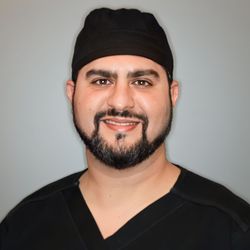Dental laser technology has transformed everything from the way we treat gum disease to how tooth decay and sensitivity are managed. But not all lasers or “laser therapies” are created equal. Understanding the type of technology that your dental provider is using can ensure the best care results and experience for your smile’s health.
One of the treatments we offer in The Woodlands and Conroe is laser periodontal therapy. Compared to traditional gum treatment (like deep cleanings or “scaling and root planing”) laser therapy is a more efficient way to combat oral infections.
Is laser periodontal therapy ideal for your needs? Here’s what you need to know:
Gum Pocket Reduction
Periodontal “pockets” and their severity are one of the biggest factors when it comes to aggressive gum disease. For those of us with healthy gums, the tissues attach to the roots of our teeth and leave a shallow 2-3mm “sulcus” around the tooth. This sulcus can accumulate plaque bacteria (and tartar, consequently) that causes an infection and gum detachment. As the gums detach, they create a deep pocket underneath your tissues next to the teeth. Deeper pockets indicate more advanced stages of the disease. They’re also a reflection of surrounding bone loss.
By reducing the depth of the pocket, we can halt the advancement of the disease and additional bone loss.
Pocket reduction can be performed in one of two ways. One is using a laser to gently remove excessive tissue along the neck of the tooth, shortening its overall height. The other is treating the inside of the pocket with a laser to facilitate reattachment between the gum tissues and the root of your tooth.
The shorter your periodontal pocket becomes, the more likely you’ll be to preserve your tooth. Plus, shallower pockets are easier to clean and maintain on a day-to-day basis. Thorough cleaning of the pocket with a water flosser or traditional floss will lower the number of bacteria and infected tissues inside of your mouth.
Laser Perio Therapy Benefits vs. Risks
There is practically little to no risk when it comes to incorporating laser therapy into your periodontal care plan. But on the other hand, not using lasers is more of a gamble. Although plenty of people see improvement in milder to moderate gum treatments following deep cleanings, those with the more aggressive disease do much better when lasers are implemented into their care plans.
Alternative to Conventional Scaling and Root Planing
Deep cleanings — otherwise known as periodontal scaling and root planing — are more of a mechanical type of process. Physical debridement and removal of tartar can be a sensitive and even lengthy experience. Each step of the procedure is usually performed by feeling the root surfaces with a thin and precisely tipped instrument. On top of that, only one side of the pocket is treated: the root.
But periodontal pockets involve the surrounding gum tissues as well. Laser treatment is an ideal alternative, as some lasers can both remove tartar buildup as well as treat the infected tissues adjacent to your tooth. As it does, it establishes a healthier environment where the gums can physically reattach to the root of the tooth. And unlike conventional root planing, laser therapies like LANAP are proven to regenerate the bone in that location. Stand-alone deep cleanings cannot.
Is Laser Perio Therapy Safe?
Absolutely. Dental lasers are FDA-approved medical devices that are proven safe and effective when used as directed. Periodontal lasers and their settings are different than the same types of lasers your dentist might use for a drill-free filling. The type and level of laser are adjusted depending on the tissues being managed. As such, the training of your dentist is just as important as the type of laser technology that they’re using. You wouldn’t want to use just any type of dental laser on an area of delicate gum tissues. In dentistry alone, we frequently utilize two separate types of lasers (Er-YAG and Nd-YAG, or a combination of the two) depending on the situation at hand.
Laser gum treatments are safe, as long as you’re careful in choosing the best provider. Their experience and access to varying levels of technology will influence the outcome of your care. Our doctors at PCE have been gum specialists for over three decades and laser dentistry practitioners for more than 10.
Does Laser Gum Treatment Hurt?
Most people don’t equate dentistry or gum surgery with the word “gentle.” But laser gum treatment is a minimally invasive technique that consequently is more relaxing for our patients. As the laser creates warm sensations and beeps, you’re likely to only experience a bit of mild pressure. Since the laser therapy is combined with a deep cleaning of pocket areas, we’ll still want to thoroughly numb the treatment area with local anesthetic. Essentially you shouldn’t feel anything more than light pressure as we move from one area to the next.
If you’re someone who struggles with dental anxiety or phobia, be sure to let us know. Additional steps can be taken to put your mind at ease. Although laser treatments aren’t usually something you need sedation for, there are of course exceptions for nearly everything. Mild to deeper dental sedation can help you overcome the anxiety that interferes with accessing the care you deserve.
What is LANAP?
LANAP is an FDA approved laser-assisted regeneration technique that stands for “laser-assisted new attachment procedure.” The laser itself is applied to diseased tissues inside of gum pockets to halt and reverse the deteriorative infection process. It can safely eradicate the bad bacteria and infected tissues while safeguarding the healthy gingiva (gum tissues) around them.
Depending on which type of technology is being used (such as the Fotona TwinLight) the dental laser can provide different types of wavelengths to provide the best results. For instance, two of the popular lasers we use are the Er-YAG and Nd-YAG. Some require three steps while others require five
Our doctors at PCE have been providing laser gum treatments for well over a decade. In fact, he taught with some of the experts who innovated laser therapy protocols and revolutionized the dental industry. Research was performed on hundreds of different lasers to discern which ones had backed clinical research when it came to regenerating the bone around teeth.
If you have gum disease or need to see a specialist, be sure to ask them if they offer LANAP or some type of laser perio therapy. When your provider is equipped with the right resources and experience, they will be better able to treat your unique situation in the most proactive way possible. Offices that don’t have access to LANAP technology may be less likely to suggest it to their patients, even if it may be the superior treatment option.
LANAP Alternative to Gum Surgery
Before laser gum treatments like LANAP became available, most treatments for advanced periodontal disease involved gum surgery. Sometimes this process was referred to as “flap surgery”. Essentially, it involved physically retracting the outlying gum tissues to expose the roots of teeth and the infected pocket-lining tissues around them. Once the area was thoroughly cleaned and treated, the gingiva (tissue) was sutured back into place.
As you might guess, gum surgery typically requires a more extensive treatment and longer recovery time. The incision process itself triggers inflammation and swelling throughout the healing process. Since LANAP doesn’t require any incisions, it’s much more comfortable (and the “recovery” is as little as 24 hours.)
Most importantly, LANAP is known to stimulate new bone growth and gum reattachment in the least time possible. It’s the only periodontal therapy that’s scientifically proven to do so. Our doctors at PCE highly recommend LANAP for treating periodontal infections for these two reasons especially. When given the option of better and faster results, it’s a simple choice.
What Kind of Results Should I Expect from LANAP?
What once started as an experimental process became the go-to procedure for treating generalized periodontitis and gum disease. Although it’s not a “gold bullet” per se, LANAP laser therapy can eliminate up to around 80% of disease inside of someone’s mouth. The remaining areas typically still call for conventional gum surgery. The time invested and result outcome from LANAP provides you — as a patient — with the best return on investment.
Laser therapies essentially speed up your body’s natural healing process. Instead of trying to manually clean pocket areas after a deep cleaning to prevent re-infection (and facilitate re-attachment), you can feel confident knowing that part of the process has already occurred. As coagulation forms a sticky-type attachment between your gums and tooth root, you’re already working with a shallower pocket. In turn, this process equates to easier home care and improved results.
Your results won’t be officially known until you return for a re-evaluation a short time after your laser therapy. At that point, we can gently measure the attachment levels between your gums and teeth.
What about bone regrowth? LANAP is one of the only clinically proven treatments known for stimulating bone growth. Since a stable foundation of bone is essential for tooth support, the potential to grow new bone around tooth roots has revolutionized the way dentists and dental experts treat periodontal disease. Diagnostic digital images can be taken at periodic intervals to assess bone height or anatomical changes once LANAP is completed.
Benefits of LANAP
Working with a gum expert who provides laser therapy will improve your treatment success rate. Especially when they have the right types of lasers for your care needs. Some of the benefits you’ll be able to experience from LANAP therapy include:
Faster recovery times.
Compared to traditional gum surgery, LANAP patients have much quicker recovery times after their treatment. You’re looking at closer to a day as opposed to more like a month. As a general rule, we usually tell patients it will be about a 24-hour timeframe before things feel back to normal. There’s no cutting and no sutures, plus the laser itself is capable of “jump-starting” the healing process.
Improved bone health.
LANAP is one of — if not the — only laser therapies that is proven to potentially stimulate bone growth around teeth. Bone does not re-grow after conventional perio therapy treatments. But the stimulation process that occurs when lasers are administered is something that goes outside of the bounds of conventional dentistry. The laser technology (as long as specific types of lasers are used) can essentially reverse some bone loss and thereby be more proactive in stabilizing affected teeth
Minimized impact on your gum height.
You may naturally assume that gum disease treatments automatically mean preserving the height of your gums. But more conventional surgeries actually have to reduce gum height in order to shorten the pocket depth around tooth roots. As a result of the tissue loss, teeth are more prone to sensitivity, root-surface cavities, aesthetic issues, and food or tartar accumulation between them. Laser therapy is one of the only ways to preserve the tissue height you already have, safeguarding your underlying tooth from unnecessary exposure.
Naturally stimulated tissue reattachment.
Most importantly, LANAP is designed to reattach gum tissues to the roots of teeth. When the tissue reattaches, the pocket area naturally becomes more shallow. As a result, you’re less likely to experience bacterial accumulation because the areas are easier to clean at home each day. The results of tissue reattachment occur much more quickly with LANAP. How? Because of the way the laser eradicates the diseased tissues and triggers coagulation in the blood at that area. When coagulation occurs, the healing process fuses the neighboring gingiva (gum tissue) to the clean, porous tooth root immediately next to it. Like a scab that forms and fuses skin in the area of a cut, this process ensures proper healing is taking place. It is the most important factor in why LANAP is the go-to treatment for people with gum disease.
What to Expect on the Day of Treatment
Essentially, the LANAP process uses a thin laser tip that “evaporates” the bad tissues inside of a gum pocket. Then the area is thoroughly cleaned (scaled and root planing) or a different type of laser is used that also removes the tartar at the same time. Finally, the laser is re-applied to the area. At this step, the laser stimulates blood flow and jump-starts the clotting process directly against the root surface of the tooth. The ultimate goal is for your gums to reattach to the tooth, holistically shortening the depth of the gum pocket (reducing your long-term risk of tooth loss.)
To ensure accuracy of treatment, our gum specialist can use a “perio scope” — which is a special microscope used to see down inside of gum pockets — to ensure that all bacterial deposits are removed. Our doctors at PCE are even able to see the microscopic tubules (pores) on the surface of your tooth roots. Since these tiny areas can harbor bacteria, the up-close and magnified view allows that much more accuracy when it comes to combatting tooth loss. We are one of the first dental providers in the country to use perio scope technology, which is now regarded to be one of the essential “must haves” in specialty practices.
Best Candidate for Laser Treatment
We highly recommend laser gum treatments like LANAP for the majority of our periodontal disease patients. Chances are, you’re not visiting our periodontal specialist unless you’ve already been diagnosed (or suspect that you have) moderate to aggressive periodontitis. At that point, most individuals meet the protocols for LANAP therapy. And if you have a milder case, laser treatment can still be extremely successful for eradicating the bacteria responsible for your oral disease.
If for some reason you need to have a tooth extracted — like if you’re planning to place a dental implant in that area — we can use an Er-YAG laser to disinfect and decontaminate the socket after the tooth is removed. Since dental implants shouldn’t be installed in an area with existing gum disease, and since teeth are usually only removed if the disease is severe, incorporating the laser treatment provides the best short and long-term benefits for our patients.
Our laser patients typically fall into one of two categories: people who contact us directly and those who were referred by their general dentist. In either instance, we can provide you with the resources and information necessary to make an educated decision about your smile’s future. You only get one permanent set of teeth. Today’s technology and resources — including dental lasers — can play a part in how long you’re able to preserve your smile. Earlier intervention and working with specialists like our doctors at PCE can improve your chances of treatment success. We’ll partner with you to create a holistic plan that keeps you smiling for years to come.
Recovery and Post-Care
Recovering from LANAP or laser gum therapy is much easier and quicker than conventional gum surgeries. Where older techniques may have called for 2-4 weeks of healing (along with subsequent tenderness and inflammation) laser treatments do not.
Since soft tissue lasers expedite the healing process and stimulate coagulation, your recovery time is drastically shortened. In fact, most people can usually return to their normal activities within about a day. One of the advantages of using the laser is that it helps to prevent inflammation, which is often one of the primary factors in post-surgical discomfort.
No sutures are necessary with laser or LANAP therapy, as the equipment does not “cut” your healthy gum tissues.
If for any reason you’re experiencing minor discomfort after treatment, it’s best to take a non-steroidal anti-inflammatory medication such as Motrin/ibuprofen as directed. Gently rinsing with warm salt water a few times a day can also be helpful. Both of these ease inflammation, and thereby potential irritation caused by everyday dental procedures.
It’s important to follow your home care instructions as directed. Smoking and caffeine should be avoided for several days. If you take aspirin or blood thinners, you don’t have to worry; they do not interfere with laser treatment the same way they might with traditional surgeries.
We might recommend avoiding flossing or using a water flosser in your treated areas for a short period of time (to prevent disruption of the coagulation tissues). After tissue reattachment takes place, it’s essential that you clean along the gumlines and within the gum pockets daily. That way you can prevent reinfection and treatment failure. The cleaner gum pocket environment, the better outcome you will have from therapy (laser or not.) But with laser treatments, it will be even better.
A modified oral hygiene plan will usually be required. If you don’t have a water flosser already, we can suggest a particular model. Water flossers are one of the best ways to maintain a clean gum pocket for continued success and periodontal health.
How to Tell if You Need Laser Therapy or LANAP
People who have symptoms of moderate to severe gum disease may experience symptoms of:
- Chronic swollen gums
- Bleeding gums
- Food collecting between teeth or under gums
- Receding gumlines
- Tooth mobility
- Tooth loss
- Heavy tartar buildup
- Halitosis
- Underlying health conditions (like diabetes or cardiovascular disease)
You might even have a family history of gum disease and tooth loss.
People who seek out laser gum treatment are often those who may have had conventional “deep cleanings” with their family dentist but didn’t see the results they were looking for. Or perhaps other health conditions have made it more difficult for your mouth to heal and bounce-back following traditional periodontal therapy. If your dentist or hygienist makes you aware of exceptionally deep gum pockets, specialized treatments beyond that of traditional deep cleanings are a necessity. Combining laser treatments with perio scopes and other resources ensures you’ll see the best outcome possible.
LANAP and Laser Gum Treatment in Conroe, The Woodlands
As one of The Woodlands’ most experienced gum experts and laser dentistry providers, our doctors at PCE are equipped with both the knowledge and resources necessary to treat your smile. Find out if laser periodontal therapy can help you treat your chronic oral infection. Contact us today to reserve your first appointment.
Office Hours
MON - THU8:00 am - 5:00 pm
FRI8:00 am - 2:00 pm
SAT - SUNClosed
Office Hours
MON - THU8:00 am - 5:00 pm
FRI8:00 am - 2:00 pm
SAT - SUNClosed














